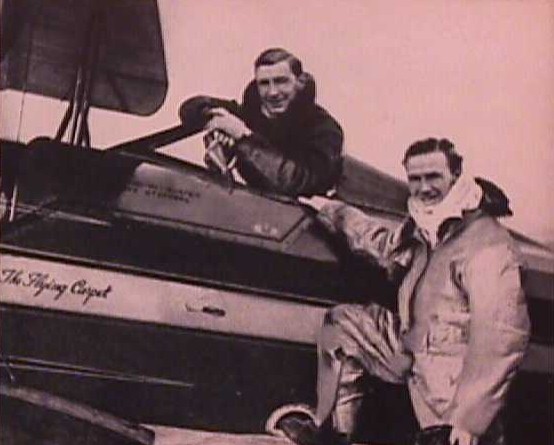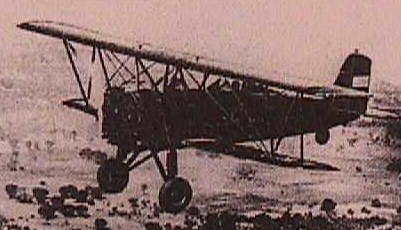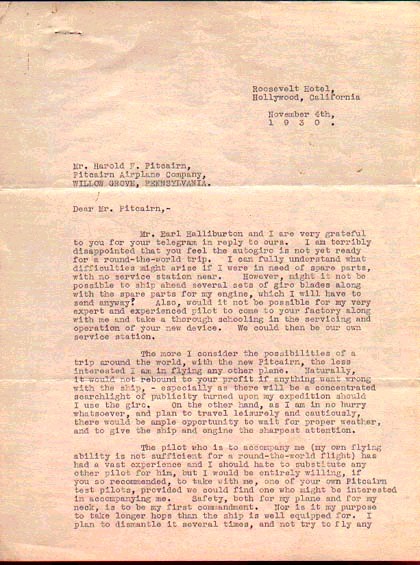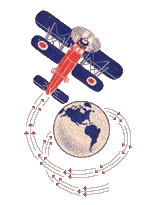Round-the-World Flights
Stephens & Halliburton Round-the-World Plane Tour
Page 2c (rev: 1000)
| Stephens & Halliburton | Plane | Flying Carpet | Halliburton Autograph | Written Letter |
|---|---|---|---|---|

|

|

|

|

|

Richard Halliburton was born in Brownsville, Tennessee on January 9, 1900 to a well-to-do family. Shortly thereafter his family moved to Memphis. He attended local schools and after high school entered Princeton's class of 1921. At the end of his sophomore year he was overcome by wanderlust which was to dominate his life. He ran away to New Orleans, where he signed on as an ordinary seaman on a freighter bound for England. He spent several months walking about England and France, taking in all he could with seemingly boundless energy. He returned to Princeton in the middle of the spring term, where his leave-taking and newfound worldliness earned him a mixture of envy, awe, and resentment. He responded by turning to writing. He sold his first piece about a hunting and fishing trip that he took to the Montana Rockies which was published in the "Field and Stream" magazine. He entertained the notion of spending his life traveling and adventuring about the world and supporting himself by writing about his activities. Upon his graduation from Princeton in the spring of 1921, Halliburton sailed for Europe, beginning his first trip round-the-world. His life was detailed in his writings.
"The Royal Road to Romance" was his first book. It detailed how the young Princeton university student cast aside any notions of a serious career , choosing instead to visit a vast array of countries from England to Japan. During the course of these travels, he undertook every sort of madcap adventure that he could find, including swimming the famed Hellespont, exploring the jungles of India, and becoming the first foreigner to astonish Japan by climbing snow-covered Mount Fujiyama in midwinter. "Let those who wish have their respectability - I wanted the freedom to search the farthermost corners of the earth for the beautiful, the joyous and the romantic," he wrote.
"The Glorious Adventure" was his second book and details how he set out to follow in the path of Ulysses, that royal vagabond who mirrored his own restlessness. It details how he roamed the Mediterranean Sea searching for adventure and romance. "I thought of Ulysses and his stirring drama, and then looked at my own life, imprisoned by apartment walls, surrounded by self-satisfied people who were caught in the ruts of convention and responsibility. All that seemed drab. I had tasted the drug of romantic travel, and I could not rest from it" he wrote.
"New Worlds to Conquer" was his third book and contains a knapsack full of that adventurer's gold - dreams brought to reality by the alchemy of his courage and daring. The book details how he set off for Latin America in search of adventure. He dived to the bottom of the Mayan Well of Death, from which hundreds of skeletons had been dredged, then swam fifty miles down the length of the Panama Canal. Not content, he climbed to the crest of Mexico's lofty Mount Popocatepetl, twice, and roamed over the infamous Devil's Island. His most amazing adventure occurred when he had himself marooned on the same island which had once held Robinson Crusoe captive.
"The Flying Carpet" was his fourth and most famous book and details his epic adventures flying a bi-plane round-the-world through remote parts of the globe. It recounts how Halliburton landed in Timbuctoo, passed over Mt. Everest, flew over the Taj Mahal upside down, and dropped down into the jungles of Borneo to visit native head hunters. He told his pilot, Moye Stephens "I've just given myself an airplane and I want you to fly us to all the outlandish places in the world, Turkey, Persia, Paris and - Pasadena. We're going to fly across deserts, over mountains, rescue imprisoned princesses and fight dragons. We must have the world. We can have the world!"
"Seven League Boots" was his fifth and last book, and details his epic adventures in a variety of remote places. "I had been commissioned to go anywhere in the world I wished and write whatever pleased me. My only orders were to move fast, visit strange places, to meet whomever was interesting - and to start at once!" he wrote. He followed these orders with passion and abandon. He dined with Emperor Haile Selassie in Ethiopia, interviewed the infamous assassin of Czar Nicholas II in Russia, tried to sneak into the forbidden city of Mecca, and finally, rode an elephant over the Alps in the tracks of Hannibal.
Halliburton was a captive of his own press. His insatiable readers demanded ever more death-defying accounts. Nearing forty, physically exhausted, and in financial trouble, Halliburton thought to roll the dice once again, hoping that the charm which had always saved him in the past would materialize one more time. It didn't! Soon after finishing he fifth book, the intrepid traveler ignored the warnings of seasoned sailors and set sail on the ship that would take him away from his book-hungry public and into the arms of a watery death. His Sea Dragon put to sea from Hong Kong on March 4, 1939. It was last heard from, via radio, on March 23, 1939, encountering heavy weather near the International Dateline. His final book was to become the ink-stained headstone of Halliburton's amazing life.
Flight Details: They began their round-the-world trek on Christmas Day, 1930 by flying from LA to NYC. There were two emergency landings en route plus a delay for an unscheduled engine overhaul. The men and plane went by ship to London, where their flying began. On the leg to France there was a severe vibration problem in the flight controls and another lengthy delay. They then flew south via Spain to Gibraltar to Fez, where they crossed the Atlas Mountains and began the 1,700 mile flight to Timbuctoo. Maximum fuel would get them to a special gasoline supply furnished by the Shell Oil Company. They followed an old trail of ruts in the sand made by truck convoys and these were likely to be covered by drifting sand. A military truck made the trip every two weeks which would be the only possible rescue in case of an emergency. They carried a two week supply of food and water.
There was no itinerary planned as they recrossed the Sahara back to Madrid and then eastward to Angora, Cairo, Damascus, Baghdad, and Teheran. Then along the west coast of the Arabian Sea to India. When he felt in the mood, and this could last for several weeks, Halliburton would write chapters for his book.
There was a side trip flying the "hump" to Nepal, and then onward to Rangoon. In January, 1932 they spent three months in Singapore where Moye fitted the Stearman with pontoons. Then on to Sumatra and Dutch Borneo where they were welcomed by headhunters. They departed with a gift from the tribe chief of 150lbs of human heads. (They dared not refuse them.) Besides the added weight, they stunk and Moye threw them overboard as they flew on to Manilla, arriving during the tailend of a typhoon. In Manila the plane was loaded aboard the USS McKinley and the trio sailed for San Francisco. At San Francisco the landing wheels were again installed for the final leg of their flight back to LA.
Among the perils they encountered was fog over the Alps, snow and hail in Persia and flying through a swarm of locusts north of Mindanao. Italian police arrested Halliburton for swimming in a Venice canal. They spent several weeks in Algeria with the French Foreign Legion. There was one occasion where Moye was demonstrating his acrobatic talent for the entertainment of local natives. He started a slow roll and suddenly stopped - Halliburton who was in the front cockpit had not fastened his seat belt.
They traveled 40,000 miles by air, Halliburton spent $50,000 for the trip, not including a $14,000 gas bill from Shell Oil Company. Royalties from his book, The Flying Carpet netted him over $100,000 the first year of issue.
